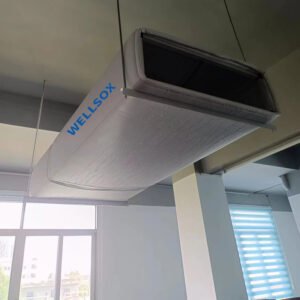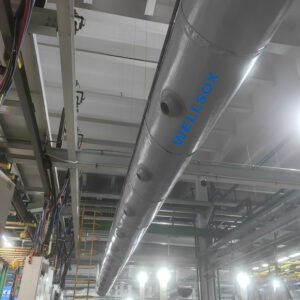Fabric air ducts have become increasingly popular in commercial and industrial settings due to their many benefits, including energy efficiency, better air dispersion, and acoustics. Fabric air ducts are made of a variety of materials, each with unique properties that make them ideal for specific applications. In this post, we’ll provide an overview of the different types of fabric air ducts and their applications.
1.Polyester Fabric Air Ducts
Polyester fabric air ducts are lightweight and flexible, making them ideal for applications where space is limited. They are also easy to install and maintain, and they offer excellent resistance to moisture and humidity. Polyester fabric air ducts are commonly used in commercial and industrial settings, including warehouses, manufacturing plants, and data centers.
2.PVC-Coated Fabric Air Ducts
PVC-coated fabric air ducts are durable and resistant to abrasion, making them ideal for use in harsh environments. They are also resistant to UV rays and flame, making them suitable for outdoor applications. PVC-coated fabric air ducts are commonly used in industrial settings, including mining and construction sites.
3.Fiberglass Fabric Air Ducts
Fiberglass fabric air ducts are made of fiberglass material, which offers excellent resistance to heat and fire. They are also lightweight and flexible, making them easy to install and maintain. Fiberglass fabric air ducts are commonly used in high-temperature applications, such as commercial kitchens, laboratories, and factories.
4.Neoprene-Coated Fabric Air Ducts
Neoprene-coated fabric air ducts are highly resistant to chemicals and oils, making them ideal for use in harsh chemical environments. They are also resistant to UV rays and flame, making them suitable for outdoor applications. Neoprene-coated fabric air ducts are commonly used in industrial settings, including oil refineries, chemical plants, and automotive manufacturing plants.
5.Silicone-Coated Fabric Air Ducts
Silicone-coated fabric air ducts are highly resistant to heat and fire, making them ideal for use in high-temperature applications. They are also lightweight and flexible, making them easy to install and maintain. Silicone-coated fabric air ducts are commonly used in commercial and industrial settings, including food processing plants, pharmaceutical manufacturing facilities, and HVAC systems in high-rise buildings.
In conclusion, there are different types of fabric air ducts available for various applications, each with unique properties that make them ideal for specific environments. Working with a reputable fabric air duct manufacturer is essential to ensure that the ducts are properly designed and manufactured to meet the specific needs of your building. By choosing the right fabric air ducts for your application, you can achieve better air dispersion, energy efficiency, and overall performance of your HVAC system.




